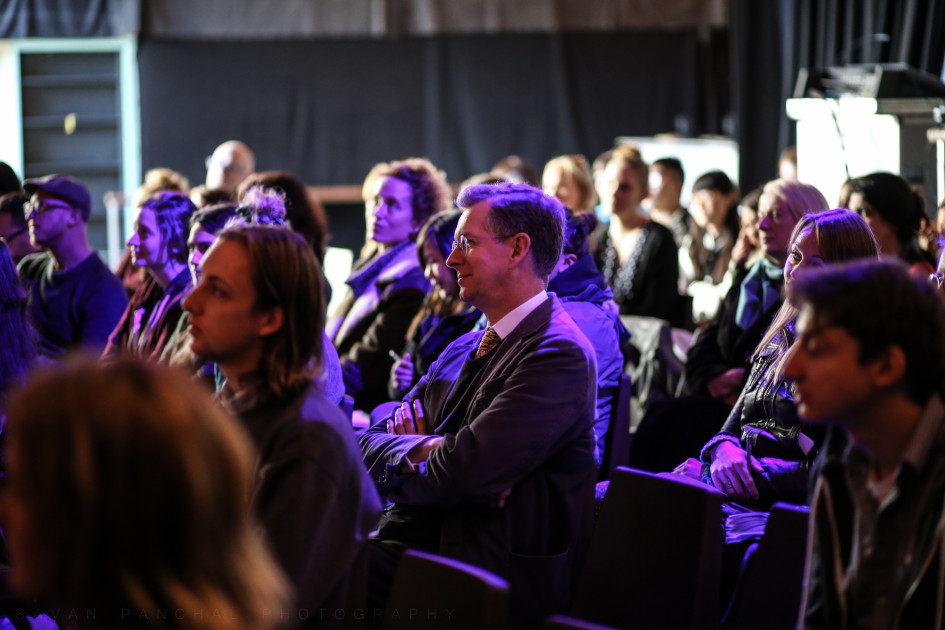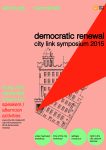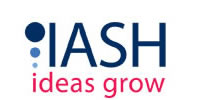Urban Citizenship in Theory and in Practice: Examples from Scotland and Denmark
by Richard Williams @rjwilliams44

The City Link Festival was initiated by GivRum, a Copenhagen-based non-profit organization founded in 2010. City Link is a ‘co-creating network of artists, activists, cultural entrepreneurs, researchers and people with ideas that link cities.’ Initially focused on creative and cultural links between Copenhagen and Hamburg, it has recently expanded its attention to include Edinburgh, and (in 2016) Istanbul. As part of a lively series of events in late September in Edinburgh, it staged a day-long symposium on ‘democratic renewal’ directed by The New Met’s Dr Stacey Hunter, with presentations of projects in Copenhagen and Edinburgh, along with Dallas.
It took place, fittingly, at Summerhall, the sprawling former Veterinary school that has become the most visible home for Edinburgh’s alternative cultures. We met in the highly atmospheric nineteenth century dissection room, which gave this good-natured event a pleasingly morbid overtone. It wasn’t an academic conference, so the organisers didn’t waste too much time over semantics. ‘Democratic Renewal’ wasn’t so much defined, as exemplified by a series of projects that eschewed the ballot box in favour of participatory action; voting was out, direct action in.
First up were Carol Hayes and Sara Melson of GivRum (literally ‘Make Space’) whose projects in Denmark showed a variety of tactics for bringing disused architectural space back to life. The projects themselves – a disused paint factory brought back to life as artists’ studios, a shipping container as a nascent central Copenhagen cultural centre – had a rough’n’ready aesthetic familiar globally. What differentiated their work from others was their attention to a social dimension: regarding their projects as social rather than architectural creations, they stressed ‘co-creation’ and the need to engage actors with often conflicting interests.

Carol Hayes and Sara Melson by Savan Panchal

City Link Audience by Savan Panchal
Next up was Christoph Lindner of the University of Amsterdam who told the tragi-comic story of New York’s High Line, a disused heavy freight rail line in lower Manhattan, now a tourist destination so popular it has had to develop crowd management measures. Once an exemplary example of citizen-led, bottom-up development, it has become the engine of a lower Manhattan real estate boom that threatens to obliterate the very characteristics it was meant to celebrate. Not long ago a space for quiet reflection, it now provides a viewing platform for viewing some of the most frenetic real estate development on earth.

Christoph Lindner by Savan Panchal
Lindner was followed by Kristoffer Thiesen, an architect for the Municipality of Copenhagen, who showed that municipal architecture need not be dull; his work seemed to be seamless with GivRum’s, indicating a degree of consensus among Copenhagen’s various actors in the built environment inconceivable in the UK. A Danish curator, Signe Pederson spoke next, on the Dream City project at the Roskilde Festival (with 130,000 participants, the Festival is rather bigger than its host city). For many of the audience at Summerhall, the image of Dream City’s Church of Beer, a vast temple of discarded Carlsberg cans will have been a highlight.

Signe Pederson by Savan Panchal

City Link Audience by Savan Panchal
After a break, Faith Liddell, Director of Festivals Edinburgh took the stage for a robust analysis of the city’s attempts to think the unthinkable through the Desire Lines project. Outwardly, Edinburgh’s festivals are unassailable: but as Liddell made clear, their success masks innumerable conflicts and exclusions. Following Liddell was Dallas’s urban activist supreme, Jason Roberts, who showed how the action of citizens could not only revitalise the odd street corner, but bring back an entire tram system. His extraordinarily impressive and ambitious work has contributed to Dallas’s status in the eyes of commentators including Alan Ehrenhalt (The Great Inversion) as perhaps the most interesting of all American cities at present.

Faith Liddell by Savan Panchal

Jason Roberts by Savan Panchal
 The day concluded with site visits to CodeBase (a major incubator space) street art projects in Leith; a hack workshop in Fountainbridge and an intimate Right to City seminar. The whole day showed another side to Edinburgh, and projected an optimistic, extroverted future. It remains a city in which culture is more often than not defined by social class as this writer discovered again to his cost recently. But for a few days, it discovered something of Copenhagen’s open-minded pragmatism.
The day concluded with site visits to CodeBase (a major incubator space) street art projects in Leith; a hack workshop in Fountainbridge and an intimate Right to City seminar. The whole day showed another side to Edinburgh, and projected an optimistic, extroverted future. It remains a city in which culture is more often than not defined by social class as this writer discovered again to his cost recently. But for a few days, it discovered something of Copenhagen’s open-minded pragmatism.

City Linkers at City Hacktivism Workshop in Fountainbridge
Follow Richard’s blog at www.richardjwilliams.net
Links to all of the filmed talks are now online at
http://city-link.org/city-link-talks/








